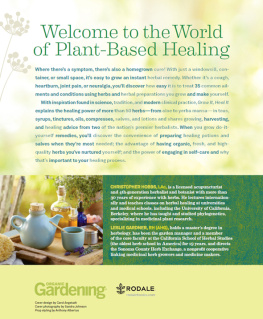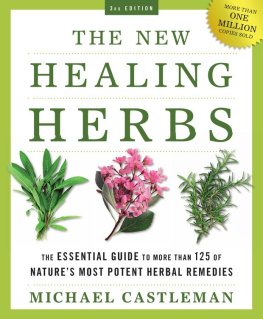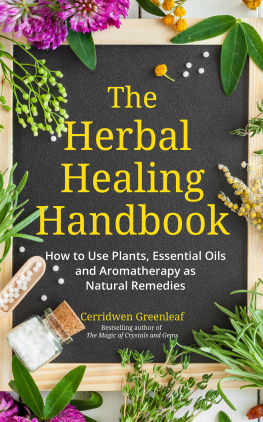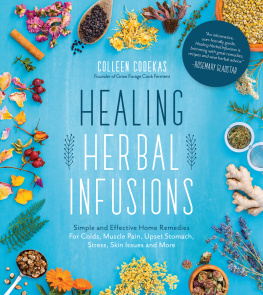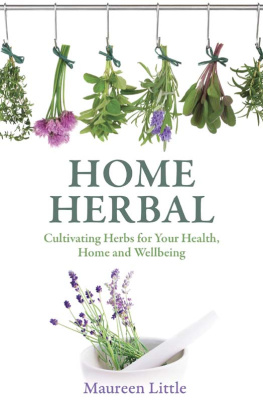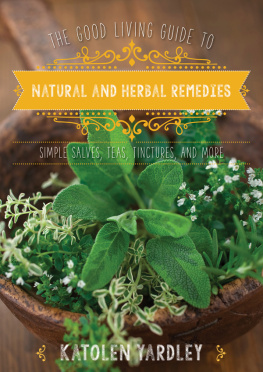This book is intended as a reference volume only, not as a medical manual. The information given here is designed to help you make informed decisions about your health. It is not intended as a substitute for any treatment that may have been prescribed by your doctor. If you suspect that you have a medical problem, we urge you to seek competent medical help.
Mention of specific companies, organizations, or authorities in this book does not imply endorsement by the author or publisher, nor does mention of specific companies, organizations, or authorities imply that they endorse this book, its author, or the publisher.
Internet addresses and telephone numbers given in this book were accurate at the time it went to press.
2013 by Christopher Hobbs and Leslie Gardner
All rights reserved. No part of this publication may be reproduced or transmitted in any form or by any means, electronic or mechanical, including photocopying, recording, or any other information storage and retrieval system, without the written permission of the publisher.
Cover and still-life photography 2013 by Sandra Johnson with prop styling by Anthony Albertus:
Plant photography:
Courtesy of authors:
istockphoto:
Rodale:
Steven Foster:
Book design by Carol Angstadt
Library of Congress Cataloging-in-Publication Data is on file with the publisher.
ISBN 9781609615703 paperback
ISBN 9781609615710 ebook

We inspire and enable people to improve their lives and the world around them.
rodalebooks.com
I would like to dedicate this book to my familymy partner, Leslie Gardner, and son, Ken Hobbsas well as all the herbalists past and present whose experience with healing plants and love of nature has inspired me and lighted my path.
Christopher Hobbs LAc, AHG, PhD candidate UC Berkeley)
In gratitude, this book is dedicated to my roots and shoots: my parents, Robert and Ruth Gardner, who make the world a better place; my beautiful Goddess, Diana; my dear Christopher and Ken; and the ancient lineage of herbalists in every page.
Leslie Gardner MH, AHG

CONTENTS
INTRODUCTION
S afeguarding health and healing have always been human concerns, and for at least 5,000 years, people have been creating herbal preparations to treat illness and discomfort.
How do we know? Fragments of what were likely medicinal plants and flowers have been found in archaeological digs that uncovered Stone Age fire sites. The Sumerians, who in the 4th millennium BCE resided in the area that is now Iraq, left written records of medicinal herbal preparations that are strikingly similar to those we use today. And the healers of ancient Egypt built a sophisticated body of knowledge about herbs and their uses that became the basis of modern medicine. In this, the Egyptians surpassed the Greeks, who embraced the practice of using diet, healthy living habits, and other natural methods to treat disease and preserve health 3000 to 1550 BCE (5,000 to 3,500 years ago).
We find the same evidence of the ancient use of herbal medicine in Asian cultures, where Ayurveda and traditional Chinese medicine have been practiced for thousands of years. The ancient herbal knowledge of the Sumerians, Assyrians, Egyptians, Greeks, and Romans was passed on through the writings of Hippocrates, Pliny, Galen, and especially the physician Dioscorides. Dioscorides lived in the 1st century CE and wrote the most long-lasting and influential herbal of all time: De Materia Medica (meaning of medicinal substances). Dioscorides was a physician in Neros army and travelled with the Roman legions for many years, and his book was the ultimate authority on herbal practice for 17 centuries! De Materia Medica was translated into Persian in the 7th century, which brought this ancient wisdom into North Africa and the Middle East, and later into the first European medical schools in Italy between the 10th and 13th centuries. From here, medical knowledge traveled northward throughout Europe over the next few centuries. It is said that the first printed book was the Bible, and the second, an herbal. Many households had these two books on the mantelpiece for centuries to come.
All of the great herbalists of the RenaissanceTurner, Fuchs, Brunfels, Dodoens, Parkinson, and the Kings Herbarist, John Gerardwrote large works that are still known and studied by todays herbalists. They are rich and colorful in their language and are an indispensable record of the human use of healing plants through the ages to that time.
Herbalism continued to be used both as folk medicine and in the professional medical trade through the 17th, 18th, and 19th centuries, culminating with the American Physiomedicalists and Eclectic Physicians, who presided over their own medical schools and journals. These traditions produced several renowned books, most notably the 1902 edition of the Kings American Dispensatory, which is still well known today and is available online.
By the 1930s, however, the medical standard was turning toward synthetic drugs as replacements for herbal preparations, although the use of herbs continued in some areas. In the United States, the 1936 edition of the National Formulary, a record of drugs prescribed and sold in pharmacies, included numerous herbal extracts such as echinacea, saw palmetto, dandelion, blue cohosh, and Oregon grape root.
Most herbs were dropped in later editions, and by 1995 only a few remained. Fortunately, the art of growing medicinal plants in a home garden and making teas and other herbal preparations is alive and well in many countries around the world today, as it has been for many centuries. In fact, an herbal renaissance (as it has been called by Dr. Paul Lee, a Harvard divinity professor who launched one of the earliest large American herbal gatherings) began to flower in the late 1960s. The famous herbalist Dr. John Christopher was traveling extensively in the United States at that time, teaching good old-fashioned herbal medicine. He promoted his favorite herbs, cayenne and lobelia, and was arrested numerous times for practicing medicine without a license.
In the late 1970s, Rosemary Gladstar founded the first American herbal school, the California School of Herbal Studies, as well as the first national herbal conference at Breitenbush Hot Springs, Oregon, in 1981. From there, a new generation of herbalists began meeting, teaching, and practicing herbalism throughout the country, and many are still active today.
You can join the ancient and modern tradition of empowered self-care and exploration by reading and using Grow It, Heal It. You, like ancient healers, hold in your hands a record of remedies that reaches back through the ages. You can grow and nurture plants that heal, just as they did. The preparations you make using the herbs from your garden or windowsill can help to ease pain, preserve health and vitality, and promote long life. And, like those who have gone before, you can gather this healing power, prepare it, and use it for the comfort and improved health of yourself and those around you.

